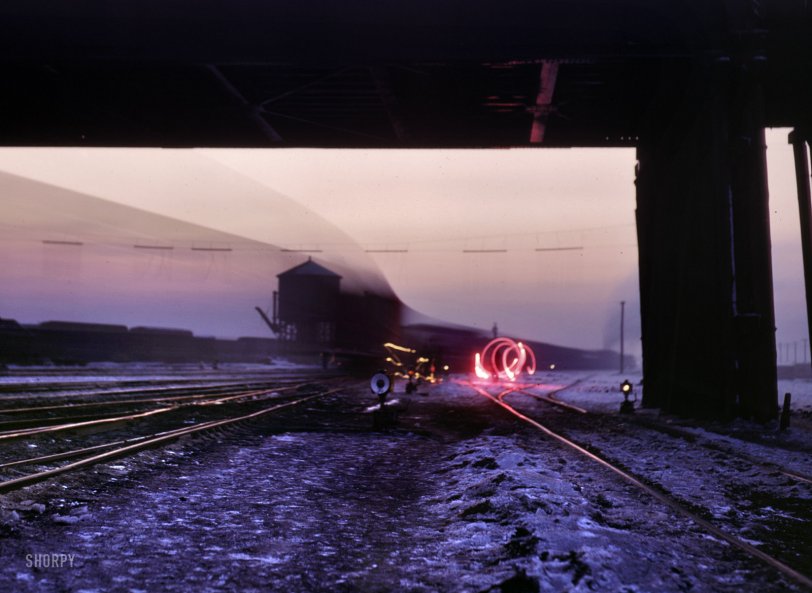


Framed or unframed, desk size to sofa size, printed by us in Arizona and Alabama since 2007. Explore now.
Shorpy is funded by you. Patreon contributors get an ad-free experience.
Learn more.

- Baldwin 62303
- Baldwin VO-1000
- Cold
- No expense spared
- Tough Guys
- Lost in Toyland
- And without gloves
- If I were a blindfolded time traveler
- Smoke Consumer Also Cooks
- Oh that stove!
- Possibly still there?
- What?!?
- $100 Reward
- Freeze Frame
- Texas Flyer wanted
- Just a Year Too Soon
- WWII -- Replacing men with women at the railroad crossing.
- Yes, Icing
- You kids drive me nuts!
- NOT An Easy Job
- I wonder
- Just add window boxes
- Icing Platform?
- Indiana Harbor Belt abides
- Freezing haze
- Corrections (for those who care)
- C&NW at Nelson
- Fallen Flags
- A dangerous job made worse
- Water Stop
Print Emporium
Twilight Departure: 1942

December 1942. Chicago, Illinois. "View in a departure yard at Chicago & North Western's Proviso yard at twilight. Brakeman is signaling with a red flare and the train is going by during exposure." Kodachrome by Jack Delano. View full size.
Telltale tales
Tell-tales are no longer needed because trainmen no longer use the roofs of cars while the cars are in motion.
"Running boards are, depending on the car's construction, wood or steel planking that provide a walking surface along the center of the car roof. In earlier times they were used by trainmen to travel from car to car to control train speed with the car's hand brakes - not an exercise for the faint-hearted.
With the development of the air brake (which allowed the engineer to control the train's speed from the locomotive), running boards were mainly used by trainmen to pass hand or lantern signals to the engine crew.
The advent of radio communication killed off this hazardous practice, though, and today it is expressly forbidden for crew members to go atop cars in motion, thus eliminating the need for running boards and the full-height safety ladders at the ends of the cars needed to get to them. Today you'll only see these components on newer cars such as covered hopper cars to allow access to loading and unloading operations.
Depending on the specific service it has been designed for, a modern box car probably sports a number of components never thought of back in 1893 when the Federal Safety Appliance Act decided to standardize ladders and running boards."
"Freight car trucks and carbodies" by Paul D. Schneider
Published: Monday, May 01, 2006 in Trains Magazine.
Tell-tales
The photo was taken from under a bridge or overpass. Faintly visible in the distance overhead are a set of "telltales," dangling ropes to warn a brakeman on top of a car that he couldn't safely remain standing as the train passed under the bridge. I remember seeing these as a child near a bridge or tunnel, generally on little-used branch lines. I have not seen a telltale in many years.
What Jack knew
4x5 Kodachrome wasn't common, cheap or fast. I imagine Jack Delano was very careful about each exposure.
I used to shoot 4x5 black & white, and I had the luxury of a darkroom where I could see the results a few hours after shooting. And I paid huge attention to composition, exposure and the subject's composure, because re-shooting was costly.
Yard signals
Below are two other Delano time exposures showing the use of signal flares. The yardmen called them fusees.
Night Life
My dad would have been the conductor out there with the signal lanterns. Once he was directing an inexperienced engineer to glide back-up and the caboose ran into Dad, slamming him between the cars. He had huge bruises all over face and body but nothing life-threatening.
Conversation starter
This one makes an excellent desktop background.
Did Delano ever know?
Did Delano ever have an idea that someday his work would be considered art? Because pictures like this and "Amethyst Twilight" definitely are.
Stoked
My dad worked for the C&NW back then. He was a fireman and shoveled coal all night. Then he got drafted and -- guess what -- he shoveled coal into a firebox on the railroad in Seattle for his military service. Thank you, Jack Delano, your picture evokes nice memories.
Awesome
These pictures always amaze me. Thanks for posting them!
Far out man!
Makes me want to turn on the black light in my bedroom and put in my Iron Butterfly 8-track.



























On Shorpy:
Today’s Top 5